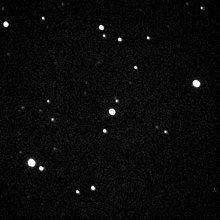|
L'étoile WASP-1
Caractéristiques physiques
| Masse |
1,301+0,049
−0,047 M☉[4] |
| Rayon |
1,60+0,13
−0,22 R☉[1] |
| Gravité de surface (log g) |
4,190+0,020
−0,022[4] |
| Luminosité |
2,837+0,002
−0,003 L☉[1] |
| Température |
6 110 ± 75 K[4] |
| Métallicité |
0,26 ± 0,08 [Fe/H][4] |
| Âge |
3,0 ± 0,6 × 109 a[4] |
Système planétaire
| Planètes |
1 : WASP-1 b |
Désignations
modifier 
WASP-1 est une étoile de haute métallicité et de magnitude 12[5], située à environ ∼ 1 300 a.l. (∼ 399 pc)[1] dans la constellation d'Andromède.
Système planétaire
En 2006, l'exoplanète WASP-1 b est découverte par SuperWASP par la méthode du transit astronomique [6].
Notes et références
- ↑ a b c d e f g h et i
(en) A. G. A. Brown et al. (Gaia collaboration), « Gaia Data Release 2 : Summary of the contents and survey properties », Astronomy & Astrophysics, vol. 616, , article no A1 (DOI 10.1051/0004-6361/201833051, Bibcode 2018A&A...616A...1G, arXiv 1804.09365).
Notice Gaia DR2 pour cette source sur VizieR.
- ↑ a et b (en) WASP-1 -- Variable Star sur la base de données Simbad du Centre de données astronomiques de Strasbourg.
- ↑ (en-GB) C Soubiran et al., « Gaia Data Release 2. The catalogue of radial velocity standard stars », Astronomy & Astrophysics, vol. 616, , p. 8, article no A7 (DOI 10.1051/0004-6361/201832795, Bibcode 2018A&A...616A...7S, arXiv 1804.09370)
- ↑ a b c d et e (en-US) Guillermo Torres, Joshua N Winn et Matthew J Holman, « Improved Parameters for Extrasolar Transiting Planets », The Astrophysical Journal, vol. 677, no 2, , p. 1324–1342 (DOI 10.1086/529429, Bibcode 2008ApJ...677.1324T, arXiv 0801.1841).
- ↑ (en-GB) H C Stempels et al., « WASP-1: a lithium- and metal-rich star with an oversized planet », Monthly Notices of the Royal Astronomical Society, vol. 379, no 2, , p. 773–778 (DOI 10.1111/j.1365-2966.2007.11976.x, lire en ligne).
- ↑ (en-GB) A Collier Cameron et al., « WASP-1b and WASP-2b: two new transiting exoplanets detected with SuperWASP and SOPHIE », Monthly Notices of the Royal Astronomical Society, vol. 375, no 3, , p. 951–957 (DOI 10.1111/j.1365-2966.2006.11350.x).
Liens externes
|

